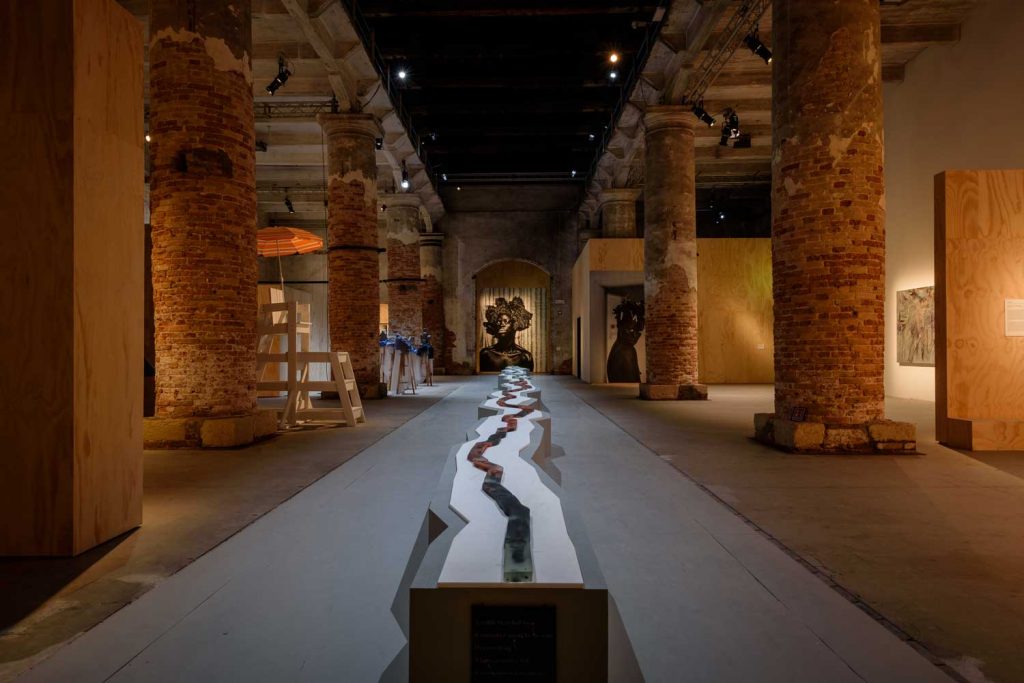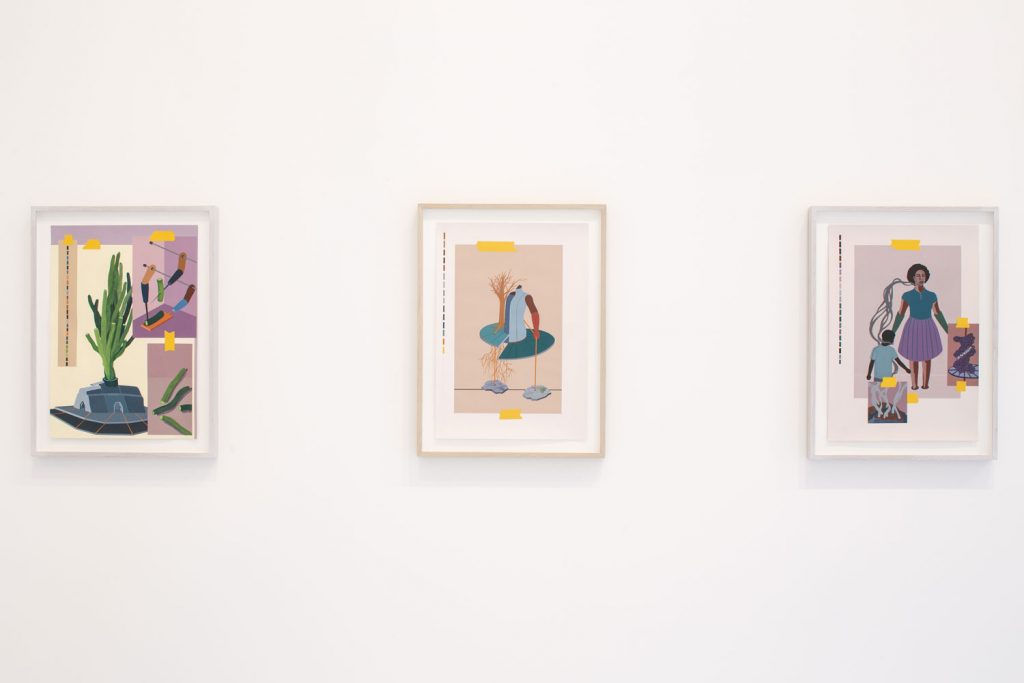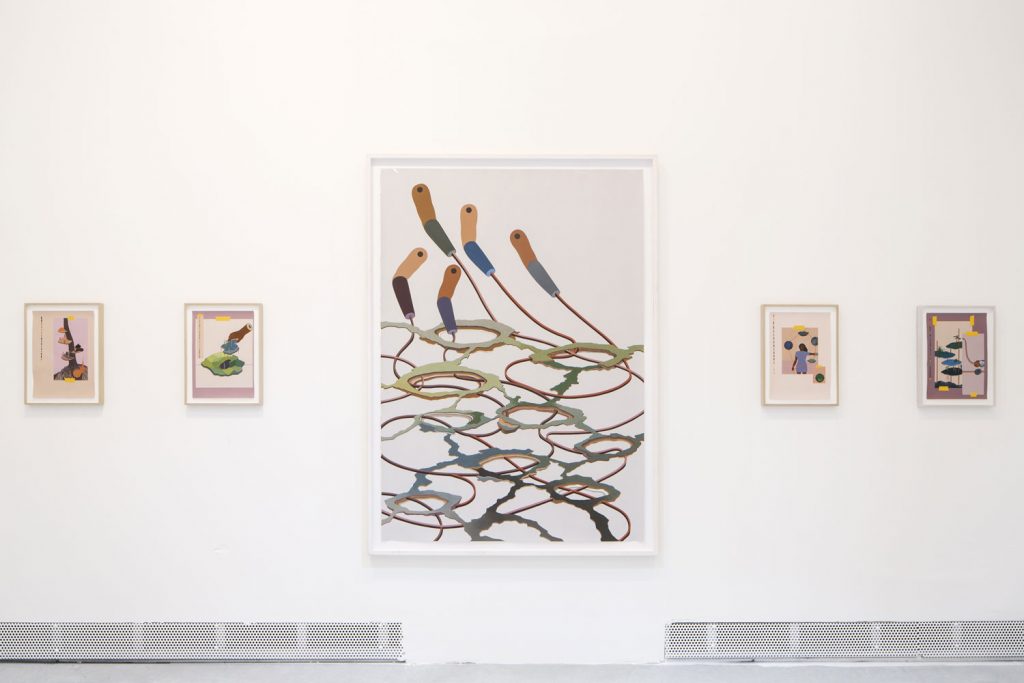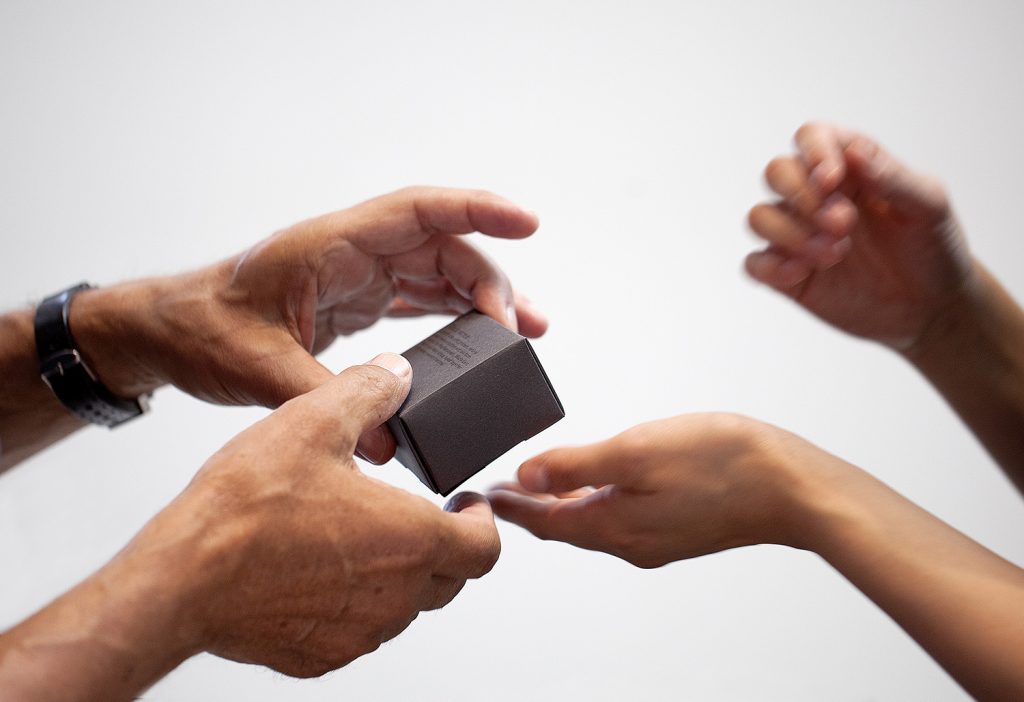Otobong Nkanga’s research addresses the relationship between man and nature, showing its historical impact, underlying narratives, and latent colonialism. Land becomes a space, full of memories and resources that contribute to the construction of potential narratives. Here Nkanga discusses her solo show “A Lapse, a Stain, a Fall” with Emanuele Guidi of ar/ge kunst, Bolzano.
Emanuele Guidi: For the exhibition “A Lapse, a Stain, a Fall” we decided to work on a new production with the support of some existing works. I would like to consider some of the latter in order to address the complexity of your practice. And perhaps the series of drawings “Filtered Memories” (2009–10) and “Social Consequences” (2009–10) make for a good starting point, as they operate as diaries, maps, and diagrams that shed light on your personal formation and on the roles of both drawing and writing in your process.
Otobong Nkanga: Many of my ideas start with drawings; they are the first place that allows the brain to reflect on things. So, there are many ways in which drawings work for me. Drawing can be the first approach to think about a work or an exhibition, starting with quick sketches or drawing directly into space in order to think things through; or it can be an intimate moment in my studio that never results in an actual piece. But I don’t make preparatory sketches. For example, for wall-drawings, I start directly on the surface that I will be working on, and then begin to think about how to put things together: what colors I could use, what I am trying to say, and how that works relative to other elements, as happened at ar/ge kunst with the central piece.
EG: It is a clear image in my memory: you drawing at night on this very long roll of paper on the gallery’s floor. How does this practice of drawing work alongside writing? We also have this beautiful poem carved into granite, which lends the exhibition its title.
ON: Well, if I look at my sketchbooks, it seems I have always been writing poetry. I find that with poetry one can really express everything that is needed without having to think about technique or the technical aspects of writing. Periods, apostrophes, exclamation marks: you can really play with that. So, for me, writing has always been in parallel with drawing. Moreover, poems allow words and sounds to play in a different way, which is more difficult to achieve with drawings. You can really start breaking down words; you discover that certain words might not mean anything, but as you play with them they can start producing relationships. So I have always been writing poetry, and it is only more recently that I’ve dared to show it.
EG: Does this have to do with a certain aspect of the body? In What Is Philosophy? (Stanford University Press, 2017) Giorgio Agamben talks about the voice as the link between meaning and the body — as the place where the flesh speaks sense. I imagine it is about ways in which feeling and thinking can become bodily. And I remember you insisting on reading your poems to me, to give a voice to those words.
ON: I think that reading a poem is about entering a different state. Not like reading an academic text. It allows the reader to pause and to think, to emphasize certain words and silences. You can create space in text by emphasizing silence. You can stretch a word, making it elastic. So, there is a place within the way of writing that allows you to feel, to enter into the state of mind of the writer — and through the way it is constructed, or broken down, it allows for some performativity.
EG: On this note, can you talk a bit about the very poetic and rhythmic title of the exhibition: “A Lapse, a Stain, a Fall.”
ON: I wanted a title that suggested a more abstract reading of the work. “Stain” is about the notion of contamination, of entering another body and becoming a stain within it. We can think of it as molecular forms shifting, as veins that have another kind of input that changes the structure of what the form should be. “Stain” is something that can make us think of collapse — of a system, of a way of thinking, or of the physical body. But I didn’t want to use the word “collapse,” so instead the idea of “falling” allows for thinking of a process of shifting, and of something that is falling into something else, whereas the “lapse” is something you miss or forget; it is the gap within the stains. It is happening and you don’t realize that a transformation is taking place; we think of a “lapse” as a lack of knowledge, or a gap, before the transformation starts revealing itself. It was a way to think about different events within these political times, when there is a lapse and things are not yet brought to the surface. It’s just a kind of void. And again, the “stain” recalls the movement of people, migrations, because people think of it as something that is staining tradition and culture; it affects how a constellation of things once was, and how it is going to transform, so we have to decide if we want to follow or to “fall” with it.
EG: The new production is titled Veins Aligned (2018). Through language, you always revisit a certain idea of the body, even when you use materials like marble and glass. The body is a very central notion in your history and production.
ON: It wasn’t clear at the beginning. It became apparent through one of the things I was “infected” by, visiting the bellies of the quarries in Lasa, and seeing the different types of veins and qualities of marble. What also touched me was travelling from Verona to Bolzano by train: watching this water, the river that appears once in a while in the landscape. We had a conversation about this landscape, which makes you feel very safe and healthy, with clean air and grapes and apples growing. But you slowly become aware of the stains, the invisible particles, the pesticides and the chemical products that are used to maintain these plantations. So, you look at the landscape in a different way, and you realize that those particles are entering the water. Veins Aligned is about working with different veins: chemicals — oxygen and hydrogen, as they come together — and the particles that slowly contaminate. The choice of using marble also goes back to the book Chromophobia by David Batchelor (Reaktion Books, London 2000), which in the first chapter talks about entering this house where everything is white, and reflecting on what the whiteness of marble in the quarries means. And when different veins of color appear, then also the cost of the marble shifts. It is interesting to see this economic side of it. And I chose a quality called “Fior di Melo,” as it relates to the apple culture of the region, and what this cultivation implies in terms of impact. Eventually, placing the glass on top of the marble was a way to think about an original landscape and an attempt to map something that is shifting form, where the marble was the original bed and the water has reduced it’s shape and form over time. Those are different thoughts that inform the work, and the act of “aligning” them is also what the title refers to.
EG: We worked on a chromatic progression of works in the exhibition because the skin of materials is also something you work with, sometimes trying to contradict their usual appearance.
ON: That comes from the experimentation I carry out with materials. We know what they normally look like, and the idea is to be able to push the perception of the way we look at things, and also to see what the material can do. So the experimentation with the soap of Carved to Flow (2017), presented for the first time at Documenta 14, came through a temperature that would act differently on the oils and butters, making it look like a marble piece, something very solid and not easily breakable. But my interest in that material was also in producing something that you can wash away, and that you can use every day before disappearing; something that looks solid, unbreakable, then becomes so fragile. I am interested in this idea of what your perception is and what the reality of material is and what it can become. Look at the glass piece in the show — from the tests we did it could look very plastic-like or very gummy-bear-like. [laughs] You realize how materials can relate to what our memory has registered. What happens if we play with that memory — try to break that perception and rediscover the material? This is an exciting aspect where the work can play with performativity; the eye in relation to the brain creates another strain of understanding and of the material itself. If you touch it or smell it, it breaks our preconceived ideas of what it is.

EG: It liberates other forms of knowledge within the material, other ways of knowing.
ON: Exactly, and it also comes with mistakes, which sometimes can be very surprising. And it can unlock another way in which to think about the work. At what stage is Carved to Flow now? I am interested especially in its function as both a pedagogical tool and support structure. After the initial two phases during Documenta in Athens and Kassel, we are now in the third phase, called Germination, which is not meant to be definite, but that will “germinate” through other institutions like here at ar/ge kunst, Raw Material in Dakar, and soon in Martin Gropius Bau in Berlin. So this third phase is both an enterprise and an educational and public program. It generates a solid economy by selling the soaps, as you are doing in Bolzano, and supporting the foundation I created that will sustain activities both in Athens and Nigeria. In Athens, we hope to reopen our space as a lab for artists and curators, and for people to understand products, whereas in Nigeria we bought a piece of land for the foundation that will be used for planting, educating kids, and for people to research local materials and making techniques. When I am invited to work with other institutions, Germination finds its way. It shifts and morphs; it can take on the form of a think tank, a workshop, or something else. It is a process that helps in thinking through an institution, its economy, and so is really about thinking together about support systems. How do you create a network that can be sustainable and that can create another form within an institution? It is meant to collapse, or fall, into another institution and start to live a life within that.
EG: We could say that we are at the center of an ecological turn in the arts with specific terms and categories widely in use. I’d be curious to know how you position yourself amid these “waves.” It seems to me you have crossed many of them.
ON: I am not too preoccupied with certain terminologies like Anthropocene, or colonial/postcolonial categories. Curators might see specific things within the work, and want to use the work, to bend it and think about a process, but for me it is not about adhering to one idea or another. My interest is in looking into everyday reality, everyday usages, economies, politics, and ecologies. So, if we look at the world from a certain perspective, and understand that it’s not a place of divisive terminology, of framing in categories, we can see its complexity. The work touches on different things that we are facing today, and that we have been facing for the past twenty years; so it’s about reflecting as human beings on this planet in relation to nonhuman objects, and how our relationships are building, and how our emotions work on these elements that we can have control over. In 2013 I was looking at materials like mica, at the notion of shine, and at places of excavation before my projects that dealt with past histories, present extractions, and future reflections. It was a whole chapter of my practice that people are still very interested in. But I think that with Carved to Flow, I’ve moved further in the way of thinking about places of extraction, and how we can start building from that, how we can start to reconstruct. Still, the reflection on extraction takes place: because when you talk about knowledge, or about reconstructing something, you are still talking about taking something and putting it somewhere else, and you have to make the system in which you are working very clear. When you gave me the choice of crediting all the people I work with, it’s important to me because you know that everything comes from the knowledge of someone else. Ideas are not only yours; it’s an accumulation, and it’s extractive energy that is taking place. How much are you aware of these processes? How do you build ethics around working with others?








